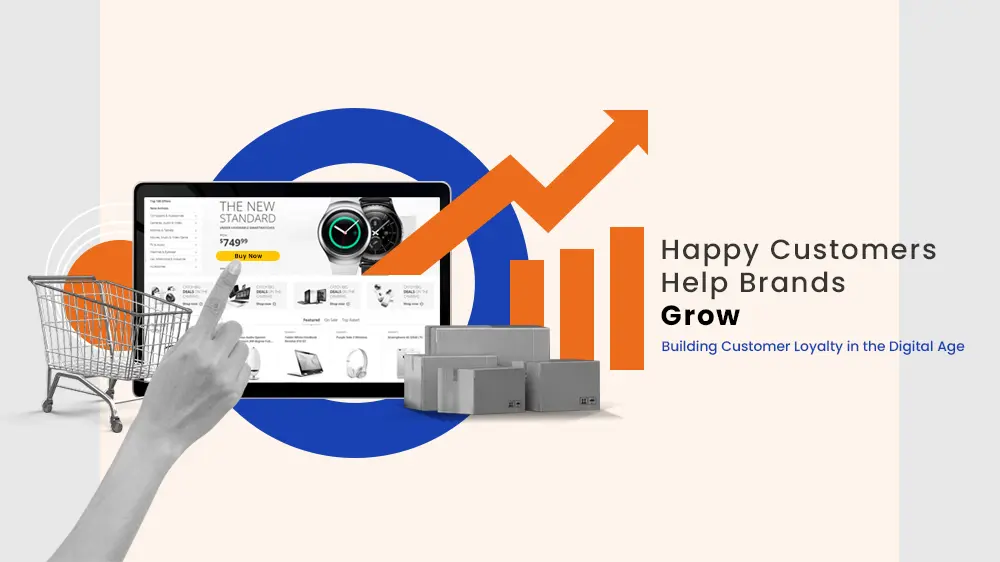Don’t Miss Out on These Brand Strategies to Build Customer Loyalty!
With a rapidly evolving retail landscape in today’s digital age, brands often find building and maintaining customer loyalty quite challenging and complex. These businesses mainly use e-Commerce as a platform, which serves as an excellent medium for quick product checkout, order confirmation, and delivery.
However, brands need to be aware of what their customers feel today; being affected by what we can call – “let’s get what’s new and shiny”. This is an effect of getting tired of using the same old brand and wanting something newer on the market. The result? An ever-changing brand loyalty quotient, shifting consumer interests, and constantly increasing competition among brands to convince their audience as to why their products are the best.
The fast-moving consumer goods industry has witnessed these changes the most. As it not only depends on e-Commerce for facilitating business, but also compels brands to constantly release new products to stay ahead of the competition. All these aspects can dramatically change customer loyalty for retail brands and affect business growth in the long term. This blog serves to tackle these challenges, so that brands can maintain customer loyalty, and still brave the highly competitive environment with a minimal brunt.
Understanding Customer Loyalty and the Shift in Consumer Behaviors
No matter how big a company or the industry it operates in, it’s at least 5 times costlier to acquire a new customer than to keep an existing one.
Today, consumers are more informed, connected and demanding, as they weigh each option appropriately before buying any product online. The power dynamics has shifted from brand happiness to consumer happiness, placing the latter in the driver’s seat. This makes it even imperative for brands to adapt and innovate continuously, putting an emphasis on following these key brand loyalty strategies:
A. Loyalty and Incentive Programs

Offering incentive and reward programs, which often are included under the umbrella of loyalty program initiatives can make customers feel immensely appreciated by the brand. Moreover, these programs can be gamified to a certain extent such as earning badges, winning contests, and reaching a particular achievement, to make purchasing retail products online more engaging. This provides customers with a feeling of being a winner, as many of these reward programs can result in cashbacks, discounts, joining/referral incentives, etc.
Integrating loyalty programs with mobile apps ensures that customers can easily access their rewards, track their points, and receive personalized offers on the go. Mobile apps also provide an avenue for push notifications, keeping customers informed about new products and promotions.
B. Personalized Customer Experience

Providing a personalized customer experience has perhaps been the most significant change that has happened in today’s digital landscape. Personalization now includes understanding customer preferences, purchase history, and customer behavior to offer relevant recommendations and experiences. FMCG and retail brands can now utilize live data analytics and AI-driven tools to segment their audience and deliver personalized, tailored content, offers, and product recommendations.
Providing dynamic content that changes based on user interactions can significantly enhance the customer experience. For example, personalized emails, website content, and advertisements that reflect individual preferences can make customers feel valued and understood.
C. Omnichannel Customer Engagement

Consumers expect a seamless experience across all channels, whether online or offline. Brands thus need to ensure that their messaging, branding, and customer service are consistent across all touchpoints. An integrated omnichannel strategy allows customers to transition smoothly between platforms, enhancing their overall experience.
Offering real-time support through various channels such as live chat, social media, and messaging apps can significantly boost customer satisfaction. Quick and effective resolution of queries and issues demonstrates a brand’s commitment to customer service, fostering loyalty.
D. Building Emotional Connections

Going beyond benefits that affect brand functions like the ones above, brands from particular industries such as retail and FMCG, possess one huge advantage compared to those in other industries – i.e. to build emotional connections with their customers. Incorporating customer stories in the brand narrative is an amazing way by which emotional connections can be forged by brands, thus aligning their values that resonate with the target audience.
Brands can create a sense of nostalgia and belonging among their loyal customers, and these two aspects work wonders to retain them. From social media campaigns to marketing initiatives focused on a single cause, building emotional connections foster loyalty and advocacy among customers.
E. Embracing Technological Advancements

Adopting AI and Machine Learning in any industry today is the need of the hour. And especially in the retail industry, these technologies can revolutionize customer loyalty strategies. These technologies can analyze vast amounts of data to identify patterns, predict customer behavior, and automate personalized interactions. Chatbots, for instance, can provide instant support and personalized recommendations, enhancing the customer experience.
Augmented Reality (AR) and Virtual Reality (VR) are two more technologies that brands can embrace to create immersive shopping experiences that captivate customers. For example, virtual try-ons for clothing and cosmetics can help customers make informed decisions, increasing their satisfaction and loyalty.
Conclusion
In the digital age, building customer loyalty requires a multifaceted approach that combines data-driven insights, personalized experiences, and consistent engagement across all channels. Companies that embrace these strategies and adapt to the evolving consumer landscape can foster lasting loyalty and drive sustainable growth. By prioritizing customer-centric practices and leveraging technological advancements, brands can turn satisfied customers into loyal advocates, ensuring success in the competitive market.
